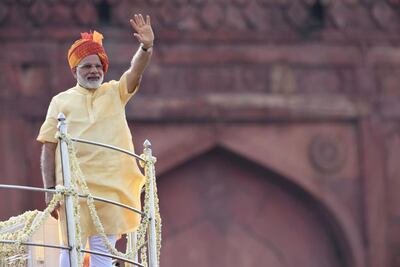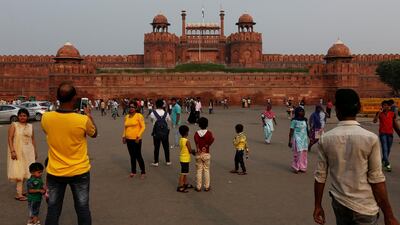Delhi’s iconic Red Fort, named for its long walls of vermilion sandstone, has witnessed many historic events over its four centuries: imperial residences, insurrections, colonial destruction, coronations and Indian independence.
On May 23, the fort will make history once more, becoming the first Indian monument to enter the custody of a corporation as part of the government’s controversial "Adopt a Heritage" programme.
The Dalmia Bharat Group, a cement conglomerate, has paid 250 million rupees (Dh13.8m) to adopt the Red Fort for five years, allowing it to advertise itself all over the monument in exchange for maintaining and improving the site to attract more visitors.
Nearly 100 Indian heritage sites are up for adoption on similar terms, including the Taj Mahal, the Sun Temple in Konark, and the Sunderbans National Park in West Bengal. The Red Fort contract was announced on Thursday, and companies have begun to bid for other sites.
“We will endeavour to make Red Fort a world-class monument in terms of amenities and experience,” said Sundeep Kumar, the executive director of Dalmia Bharat. The company plans to take initiatives that will “enhance the tourist experience”.
Historians and heritage buffs are divided over the merits of the Adopt a Heritage scheme, but they agree on one aspect: India’s historic monuments desperately need rejuvenation.
Roughly 2.5 million visitors, from India and overseas, come to Red Fort every year, only to find crumbling brickwork, vandalised walls, rubbish strewn in corners and inadequate toilets. Unregulated touts and over-solicitous guides swarm near the entrance to the fort.
If this is the condition of Red Fort — one of India’s most prominent structures, and the venue for the prime minister’s Independence Day speech every August 15 — lesser monuments pose even greater concerns.

Mahesh Sharma, India’s culture minister, admitted to parliament last year that 24 historic structures across the country had disappeared altogether, having tumbled down entirely or been destroyed to make room for encroaching urban buildings.
Part of the problem is the lack of a budget for heritage conservation, said Shikha Jain, a New Delhi-based architect and conservation consultant. “There are no funds even for protected monuments,” she said, referring to those structures deemed crucial to India’s heritage and looked after by the Archaeological Survey of India (ASI).
“Unprotected monuments are, of course, very often razed to the ground.”
The government’s budgetary allocation to the culture ministry has grown, from around 13 billion rupees in 2011 to 25bn rupees in 2016. But the 2016 figure — which is meant to cover cultural events, promotions and heritage conservation — still represented just 0.14 per cent of the government’s total planned expenditure for that year.
_______________
Read more:
William Dalrymple reveals the dark secrets of the Koh-i-Noor diamond
UAE funds rebuilding of Mosul’s Al Nuri Mosque and historic minaret
Once-neglected buildings bear mute witness to our past
_______________
Dalmia Bharat’s contract with the government specifies the kind of upgrades the ASI has failed to provide. Over the next five years, Red Fort will get new lighting systems, toilet facilities and water kiosks. The walls will be restored and the grounds landscaped. A new visitor centre and cafeteria are planned, and free Wi-Fi will be available throughout the monument.
The fort will also be leased out for concerts and other activities. Revenue from these events, as well as from visitor admission tickets, must be used for the fort’s upkeep.
The company’s advertising on banners, signboards and souvenirs must be done “in a discreet manner and tastefully,” the contract specifies.
Given the lack of government funding, Ms Jain said she welcomed the participation of “private initiative”, as long as it did not mar the integrity of the monument.
According to the terms of the scheme, a government committee will monitor all renovations, improvements and events at the heritage sites to better protect them.
But Tanmay Rastogi, a student at Delhi University and a heritage buff who regularly joins guided walks through Old Delhi — the neighbourhood where Red Fort is located — worried that the Adopt A Heritage scheme would encourage the government to wash its hands of its cultural responsibilities.
“Honestly speaking, what is 250 million rupees over five years? It’s a drop in the government budget,” Mr Rastogi said. “If a country like India can’t find that kind of money to maintain one of its most important buildings, we must have a sense of totally misplaced priorities.”
Handing the Red Fort over entirely to a company for five years is a loss of control, Mr Rastogi added.
“However tasteful the company’s advertising, it will still spoil the experience of visiting a 17th-century monument. I’m not sure things like free Wi-Fi are worth that at all.”
_______________
Read more:
How The Beatles were affected by their famed trip to India
NYUAD research hopes to predict crucial changes to India's monsoons
_______________

